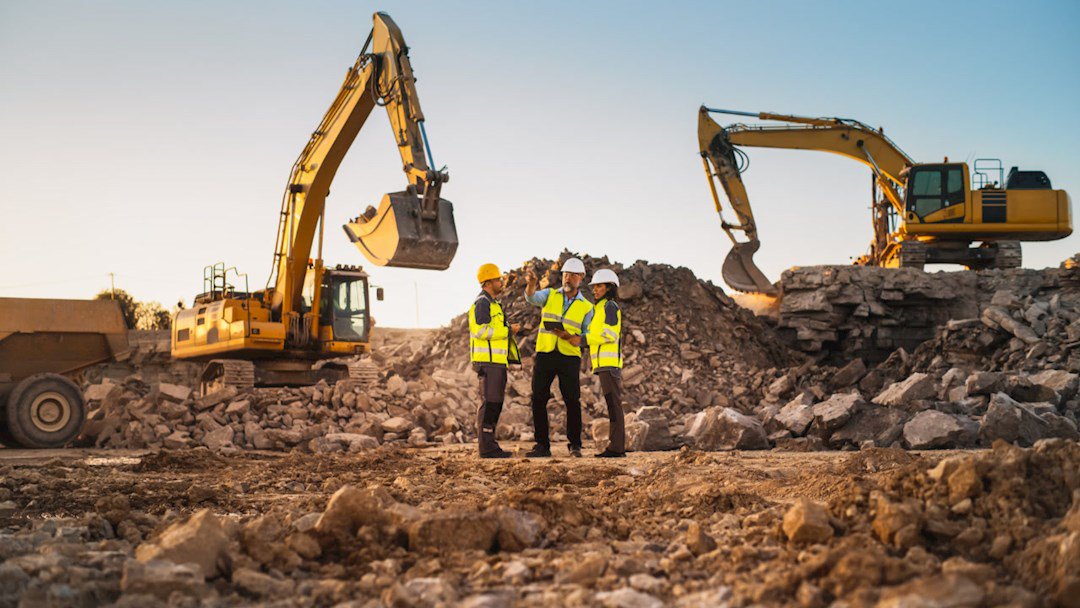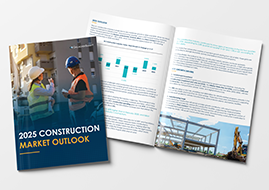
Construction projects are complex undertakings that involve numerous risks, many of which can lead to significant financial losses if not properly managed. Builder's risk insurance is designed to protect construction companies from these potential losses by covering various types of claims that may arise during the course of a project. Understanding the most common builder's risk claims can help construction companies implement effective risk management strategies to effectively mitigate or prevent these claims.
Theft
One of the most prevalent builder's risk claims is theft. Construction sites are often targeted for theft due to the presence of high-value materials and equipment. Unlike completed buildings, construction sites typically lack robust security measures, leaving them vulnerable. Incidents can be prevented or have their impacts be reduced through the following:
- Investing in robust security measures and installing security cameras, adequate lighting, and fencing around the perimeter of the construction site. These measures act as both a deterrent and real-time surveillance.
- Employing security personnel to monitor the site, especially during off-hours, further strengthens the site's defenses against theft.
- Maintaining detailed records of materials and equipment, particularly high-value items, on-site is important to ensure accountability and facilitate quick recovery in the event of theft, thereby minimizing potential losses and disruptions to the project.
Weather-Related Damage
Severe weather events, such as storms, hurricanes, and floods, can wreak havoc on construction sites. These events can cause extensive damage to partially completed structures, materials, and equipment, leading to substantial claims. To mitigate weather-related damage on construction sites, it is essential to employ a combination of proactive strategies, such as:
- Using weather forecasting tools allows construction managers to anticipate severe weather events and implement preventive measures to protect the site. By staying informed about upcoming weather conditions, managers can take timely actions to secure materials and structures.
- Using protective coverings, such as tarps, plays a crucial role in shielding materials and partially completed structures from adverse weather conditions, such as rain, wind, and debris. Securing anything that might take flight in strong winds, such as lighter materials, with ropes, sandbags, and ground anchors is also advised.
- Boarding up doors and windows and using sandbags around the perimeter of the building can help fend off water. Also, be sure to double-check that backup generators are fueled and ready.
- Removing materials and equipment from the job site can help protect items that cannot be covered or locked down during weather events.
- Ensuring proper drainage systems are in place is vital to prevent flooding and water accumulation. Effective drainage safeguards the site from water-related damage, protecting foundations and materials from the detrimental effects of excess water.
Learn more: Hurricane Safety Tips and Top Strategies to Secure Your Construction Site
Fire
Each year, construction site fires cause significant losses, with over $375 million in damages. Fires can occur due to various reasons, including electrical faults, arson, or accidents involving flammable materials. Fire damage often results in claims for rebuilding and replacing damaged materials. To help prevent fire-related incidents, construction companies should consider the following mitigation practices:
- Establishing strict fire safety protocols is essential, including conducting regular inspections of electrical systems and equipment to identify and mitigate potential fire hazards. These inspections help ensure that all electrical installations are safe and functioning correctly, reducing the risk of accidental fires.
- Providing readily available fire extinguishers on-site and ensuring that personnel are trained in their use allows for a swift and effective response.
- Properly storing flammable materials is another critical aspect of fire prevention. These materials should be stored safely and away from ignition sources to reduce the risk of fire incidents.
Read more: Construction Fire Safety and Essential Tips for Preventing On-Site Fires
Vandalism
Acts of vandalism can lead to costly repairs and project delays. Damage to structures, equipment, and materials caused by vandalism is a common claim in builder's risk insurance. Construction companies can help deter vandalism by:
- Implementing security measures such as fencing and lighting.
- Strengthening site security by installing surveillance systems to provide continuous monitoring and deploying regular patrols to deter potential vandals reduces the likelihood of vandalism. Site security could also include physical security personnel on-site to monitor construction sites during non-working hours.
- Engaging with the local community plays a vital role in the prevention of vandalism. By fostering goodwill and building positive relationships with community members, construction companies can create a sense of shared responsibility for the site's security. Community engagement initiatives, such as informational sessions or open houses, can help establish trust and cooperation, further reducing the risk of vandalism.
Water Damage
Water intrusion from rain, plumbing leaks, or flooding can damage construction materials and partially completed structures, resulting in claims for repairs and replacements. To minimize water damage, construction companies need to take a proactive approach, which may include the following:
- Applying waterproof materials and techniques is essential to protect structures from water intrusion. These materials and methods create a barrier that prevents water from damaging the construction, safeguarding the integrity of the project.
- Regular inspections of plumbing should be completed to help identify and address leaks promptly, preventing potential water damage that could compromise the site.
- Using advancements in the Internet of Things and cloud-based technologies can help detect leaks and water intrusion faster, allowing for quicker response and mitigation. Some technologies can automatically turn the water off and/or identify the source of the leak, saving time and damage.
Read more: Construction Site Water Damage: Risks and Remedies
Accidental Damage
Human error is an inevitable part of construction projects. Incorrect installation or handling of materials can lead to structural issues or damage that requires remediation. Preventing accidental damage on construction sites requires a focus on comprehensive training and stringent quality control measures. Steps can be taken to help reduce errors, including:
- Providing thorough training for workers ensures they understand proper procedures and techniques, thereby minimizing human error and the potential for accidental damage.
- Supervising projects further supports this effort by ensuring that tasks are performed correctly and safely, reducing the likelihood of mistakes.
- Implementing strict quality control measures can help ensure the integrity of the construction project. These measures involve regular inspections and testing to ensure that materials and workmanship meet the required standards, helping to prevent accidental damage.
Learn more: Safety Training and Education
Equipment Breakdown
Construction projects rely heavily on machinery and equipment. Breakdowns can lead to delays and additional costs, resulting in claims for repair or replacement. To prevent equipment breakdowns, construction companies should consider the following mitigation efforts:
- Regular maintenance and inspections of machinery and equipment are essential in helping to identify potential issues before they lead to costly breakdowns. By following a scheduled maintenance routine, construction companies can ensure that their equipment remains in optimal working condition.
- Properly training operators plays a vital role in equipment breakdown prevention. Ensuring that operators are properly trained to use equipment safely and efficiently minimizes the risk of misuse and accidents, which can lead to equipment damage. Comprehensive training programs should cover proper usage, safety protocols, and emergency procedures, equipping operators with the knowledge and skills needed to handle equipment effectively.
Structural Collapse
Although less frequent, structural collapses can occur due to design flaws, poor workmanship, or unexpected external forces, leading to significant claims. A few considerations during the building phase of a project include:
- Conducting thorough engineering reviews and inspections ensures structural integrity and adherence to design specifications. These reviews help identify potential weaknesses or discrepancies in the design, allowing for timely corrections and adjustments to maintain the stability of the structure.
- Using high-quality materials to prevent structural failures. Adhering to construction standards and codes guarantees that the materials used are suitable for the specific project requirements and capable of withstanding environmental and operational stresses.
By understanding these common builder's risk claims, construction companies can develop comprehensive risk management strategies that address potential vulnerabilities. Implementing proactive measures such as enhanced security, weather protection, safety protocols, and regular maintenance can significantly reduce the likelihood of claims and ensure the successful completion of construction projects. Partnering with risk management and claims handling specialists can help ensure that comprehensive risk management strategies are in place and incidents are effectively and efficiently resolved, protecting what matters most to your business.
Gallagher Bassett provides comprehensive end-to-end risk management solutions for the construction industry, supporting our clients from preconstruction through closeout with a focus on loss prevention, mitigation, remediation, and resolution. In collaboration with Safe T Professionals, the Gallagher Bassett Technical Services team delivers risk management solutions, including loss control, training, and site and claims resolution services. Our team of multidisciplined technical experts partners with clients to effectively minimize the impact and costs associated with construction-related risks, ensuring exceptional outcomes at every stage of the project life cycle.
Learn more about our partnered solutions for the construction industry.
Make Gallagher Bassett your dependable partner
When making the right decision at the right time is critical to minimize risk for your business, count on Gallagher Bassett's extensive experience and global network to deliver.

